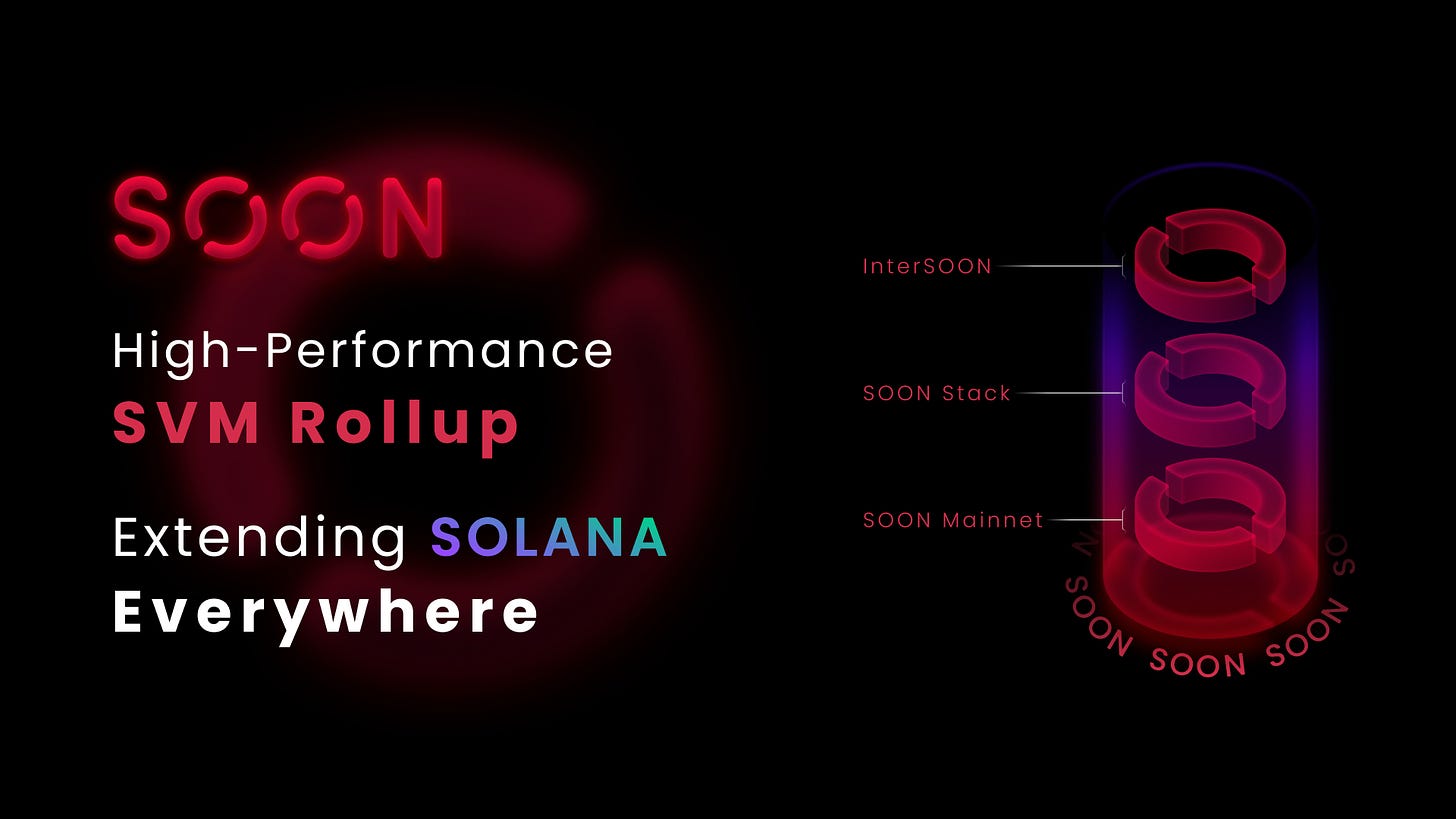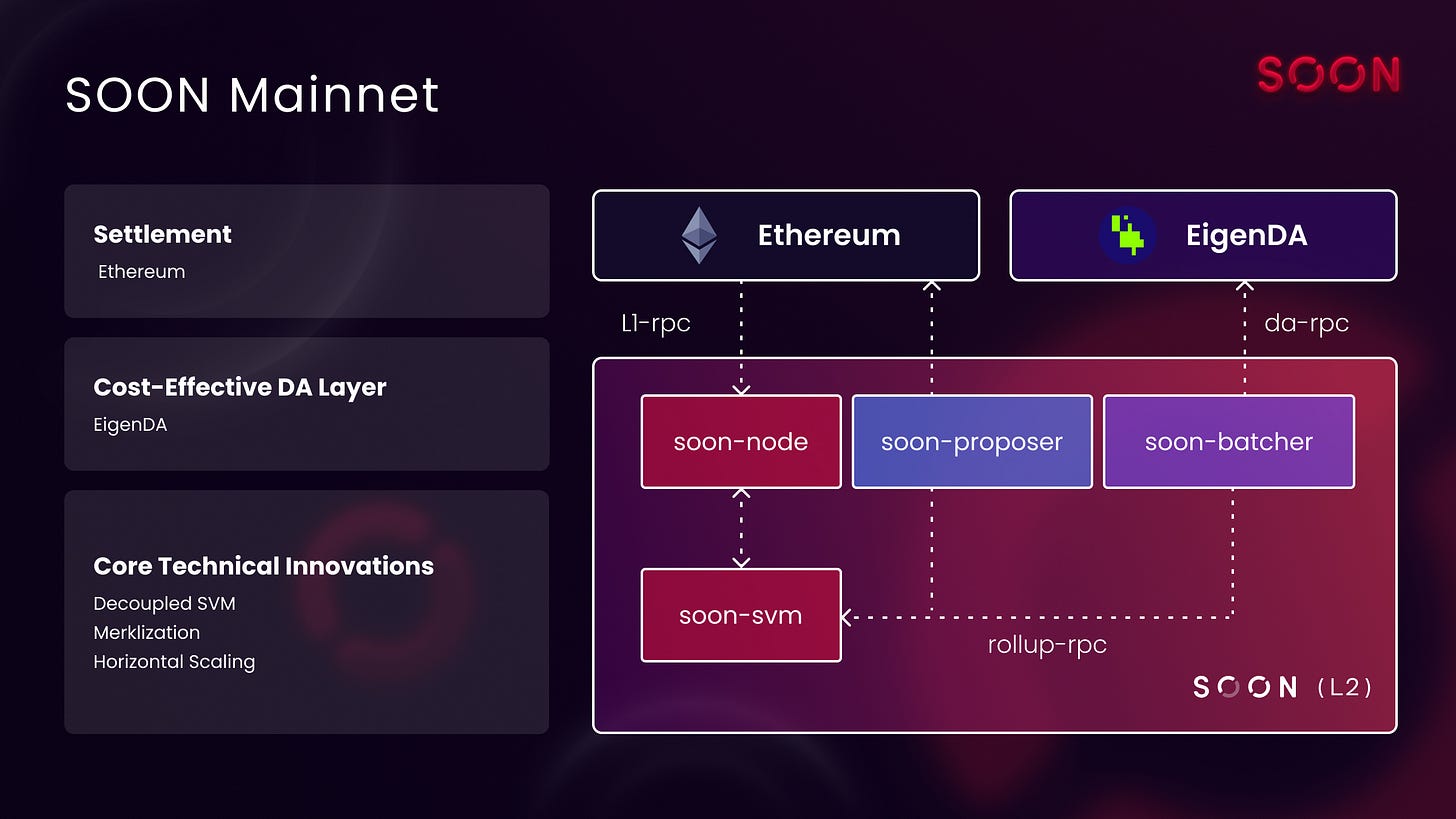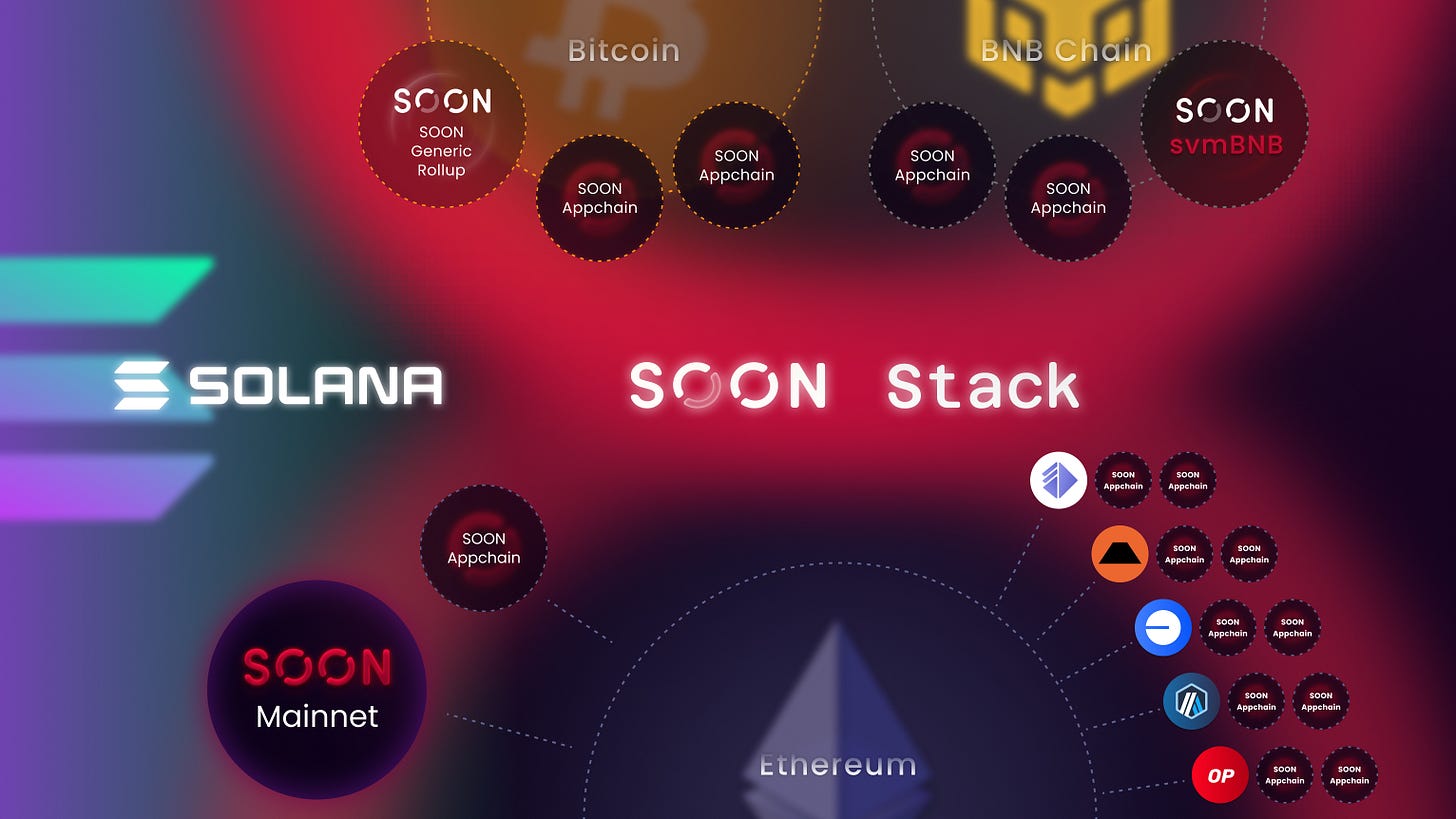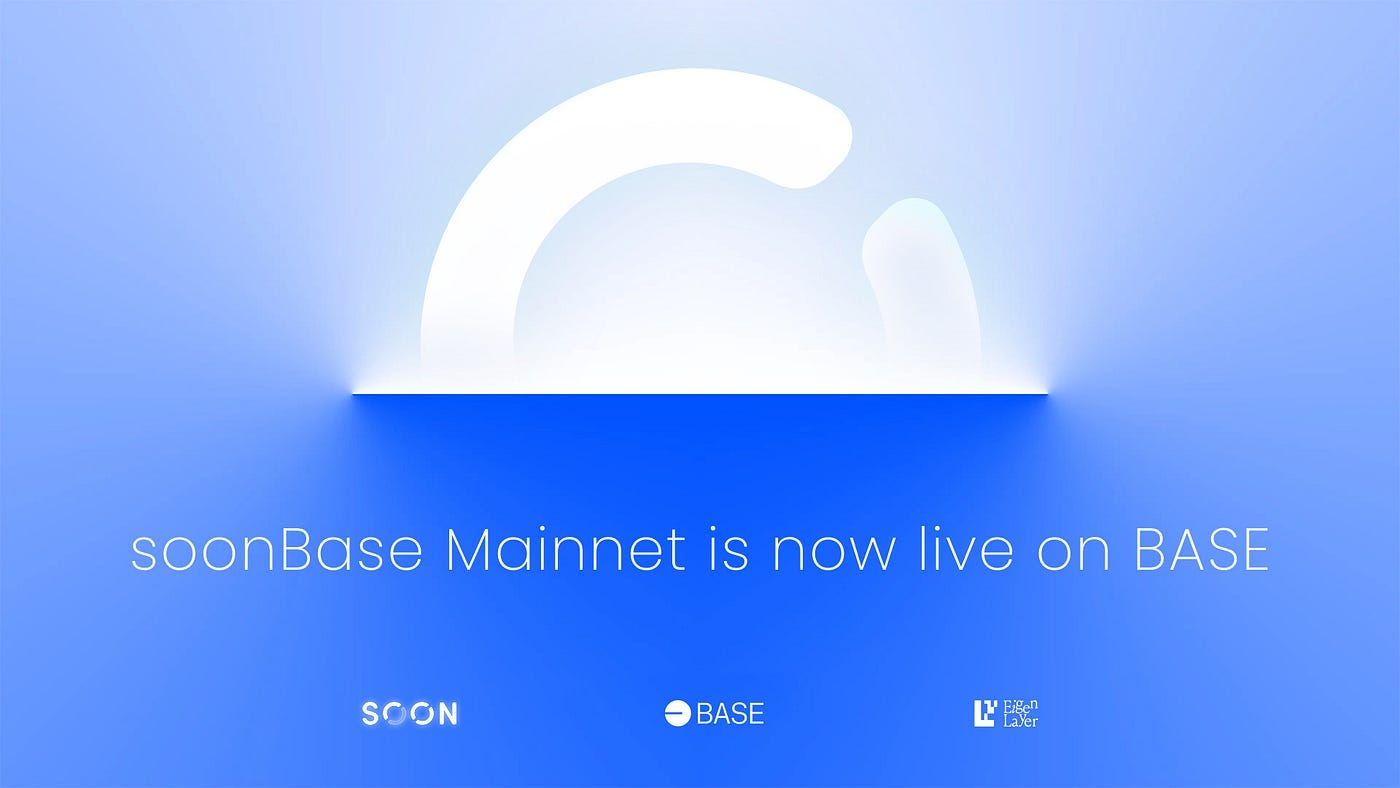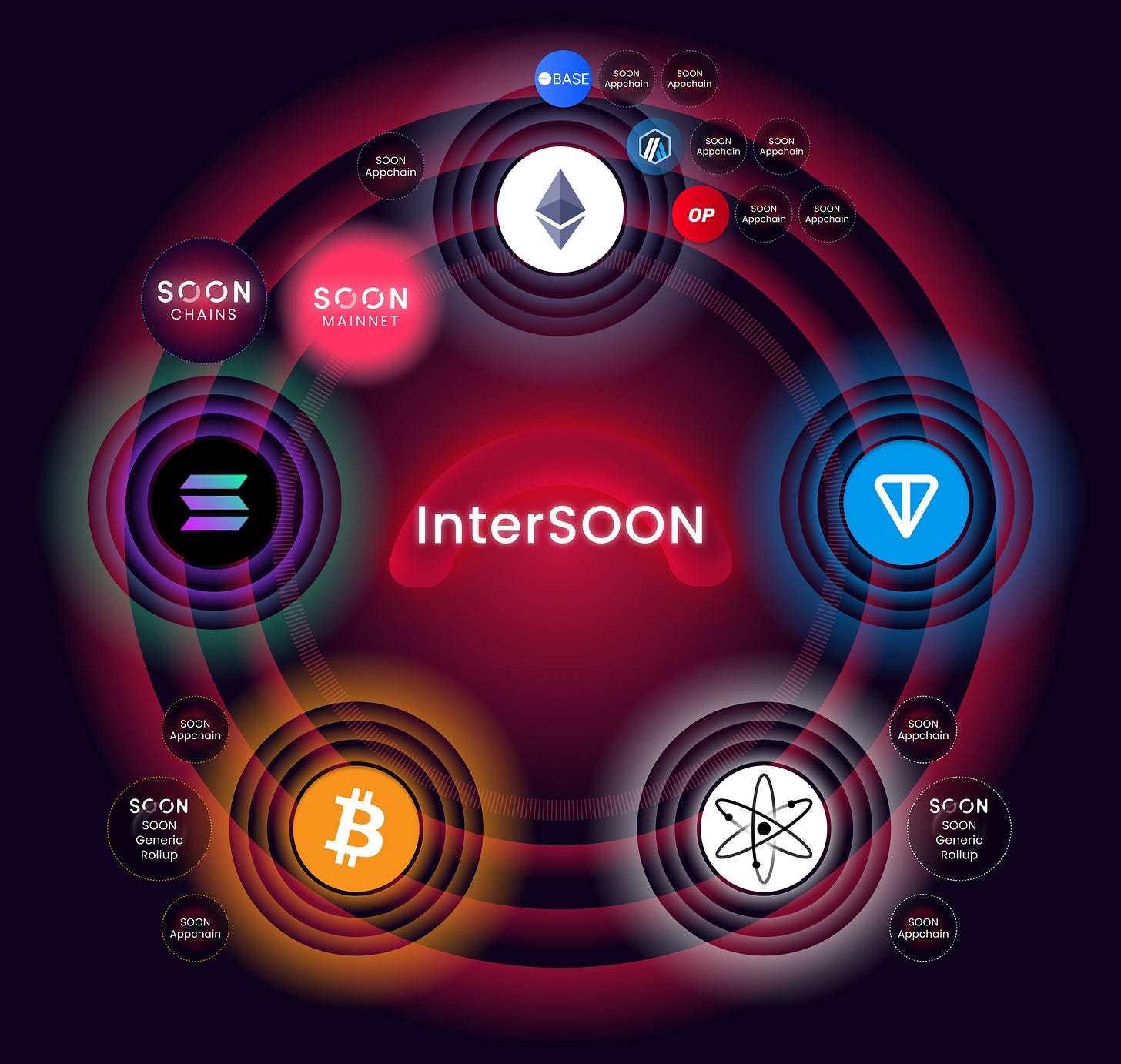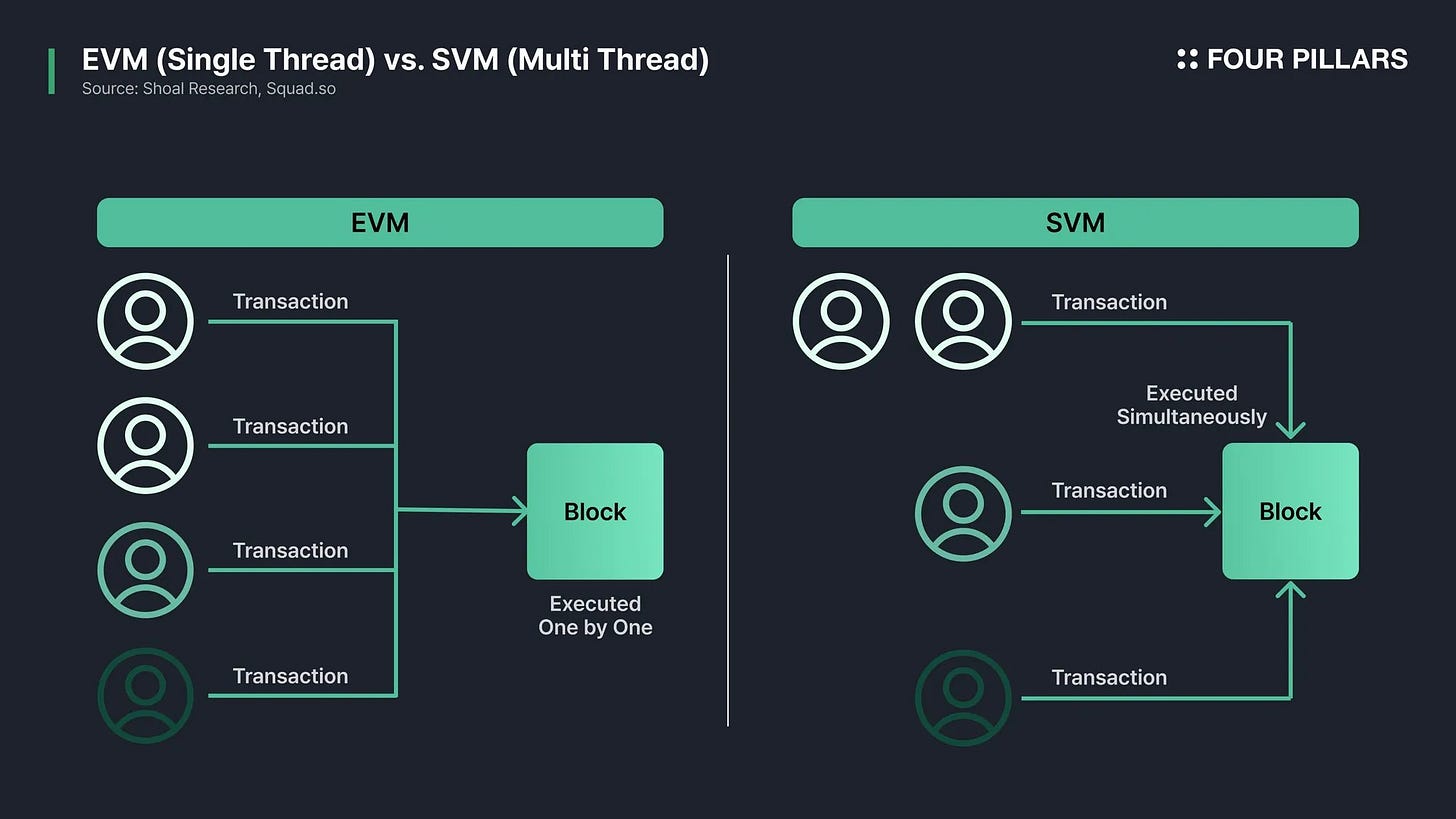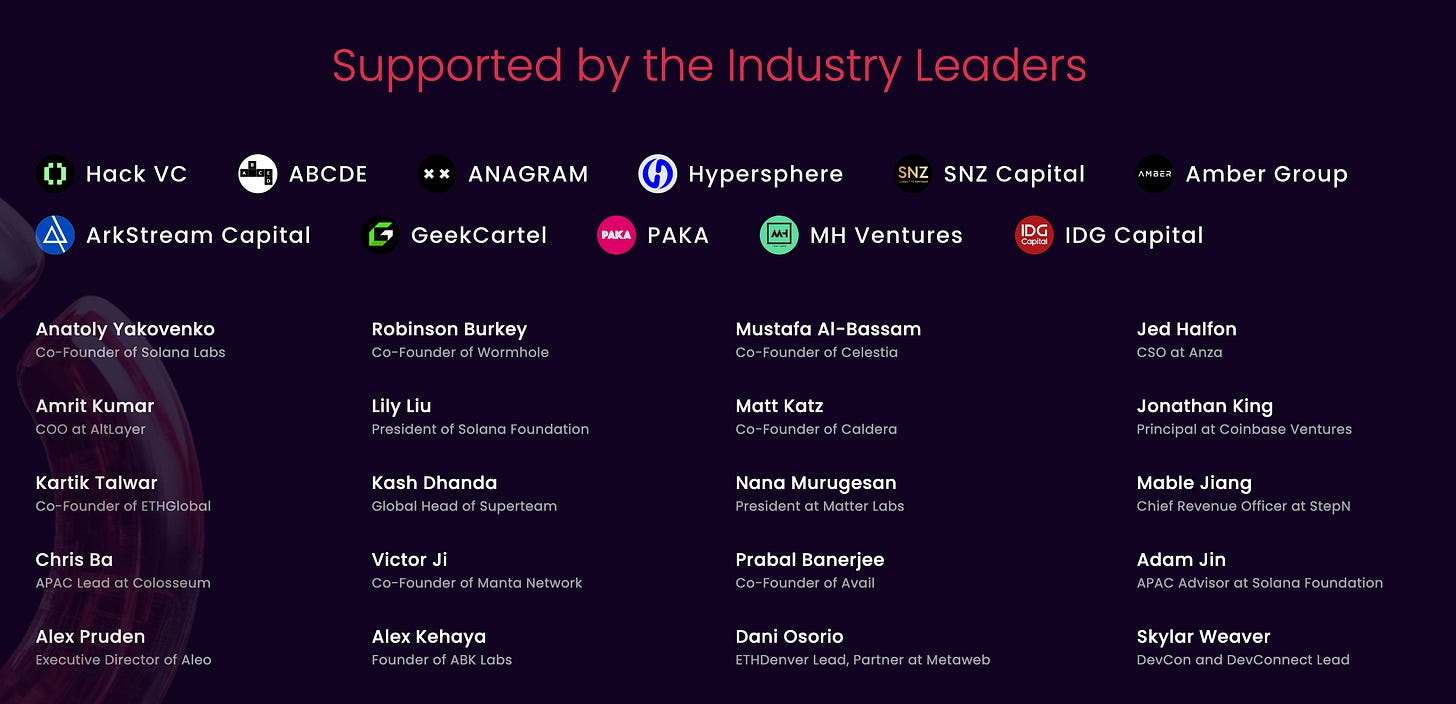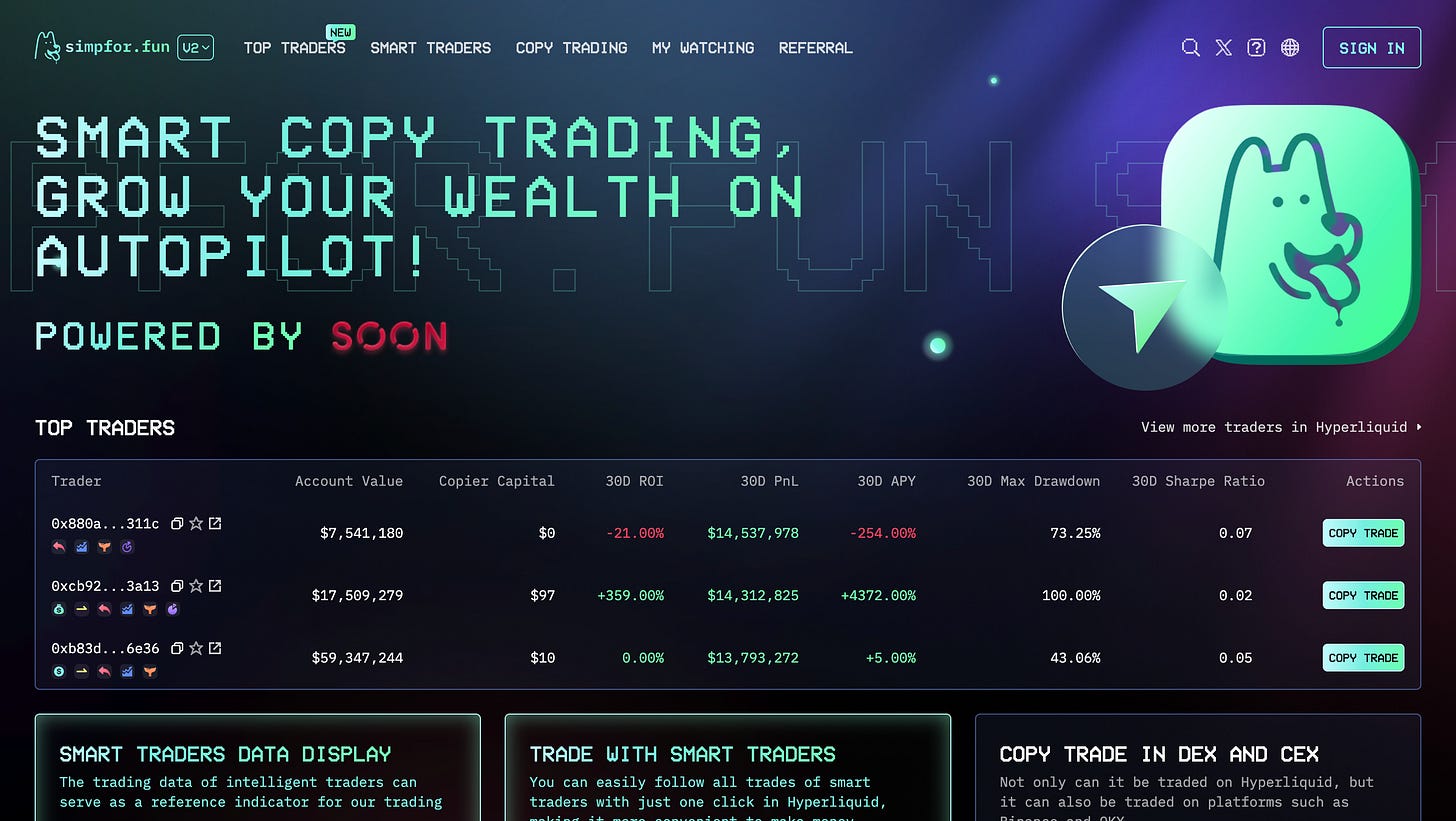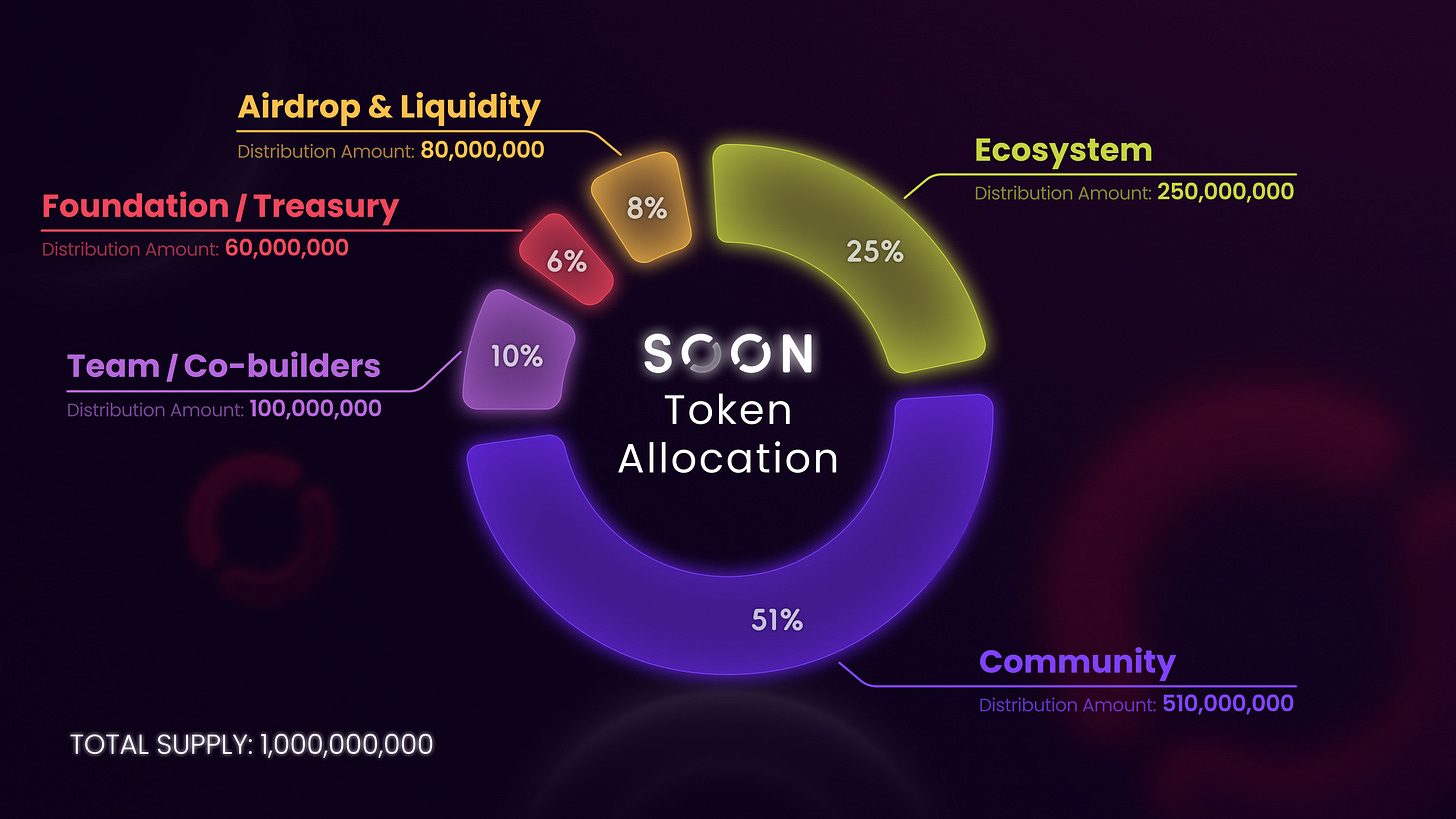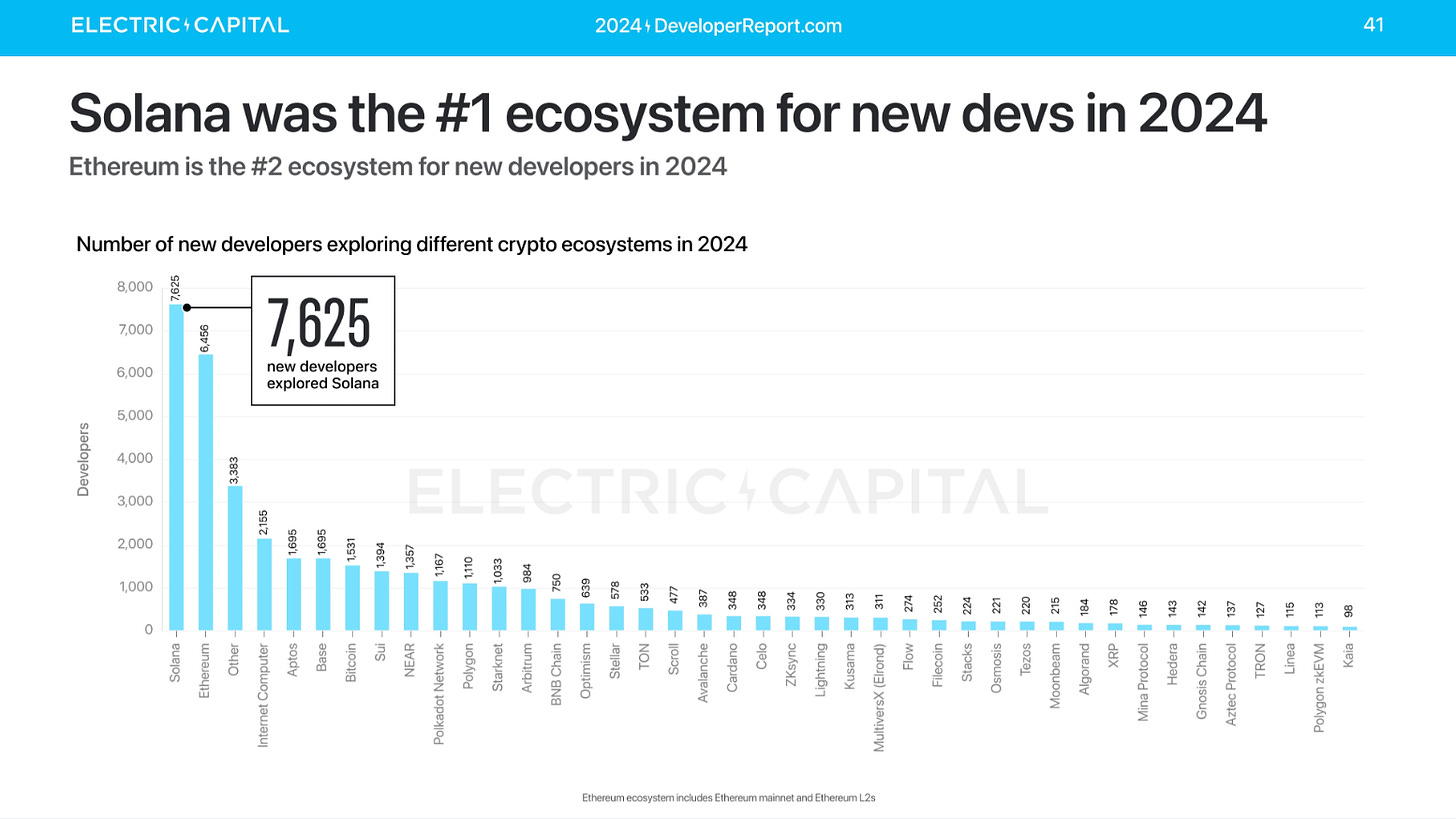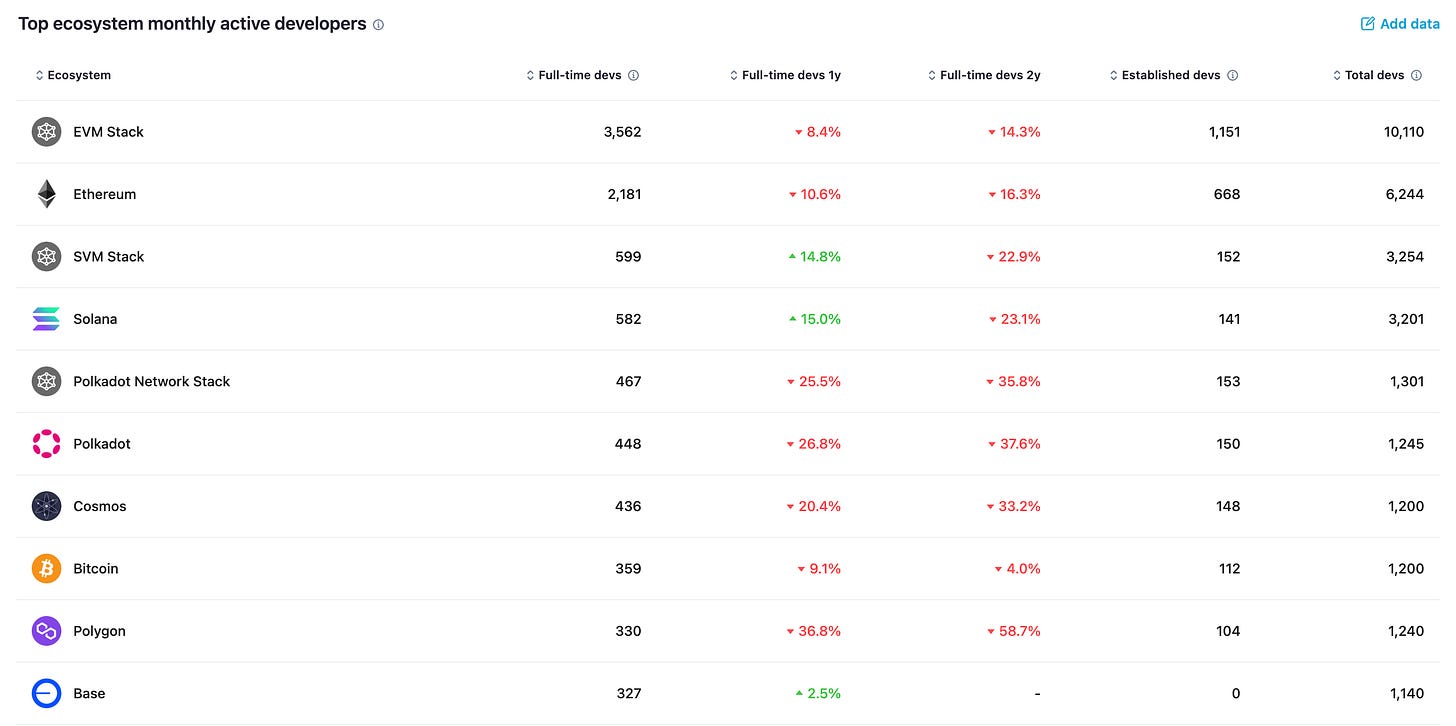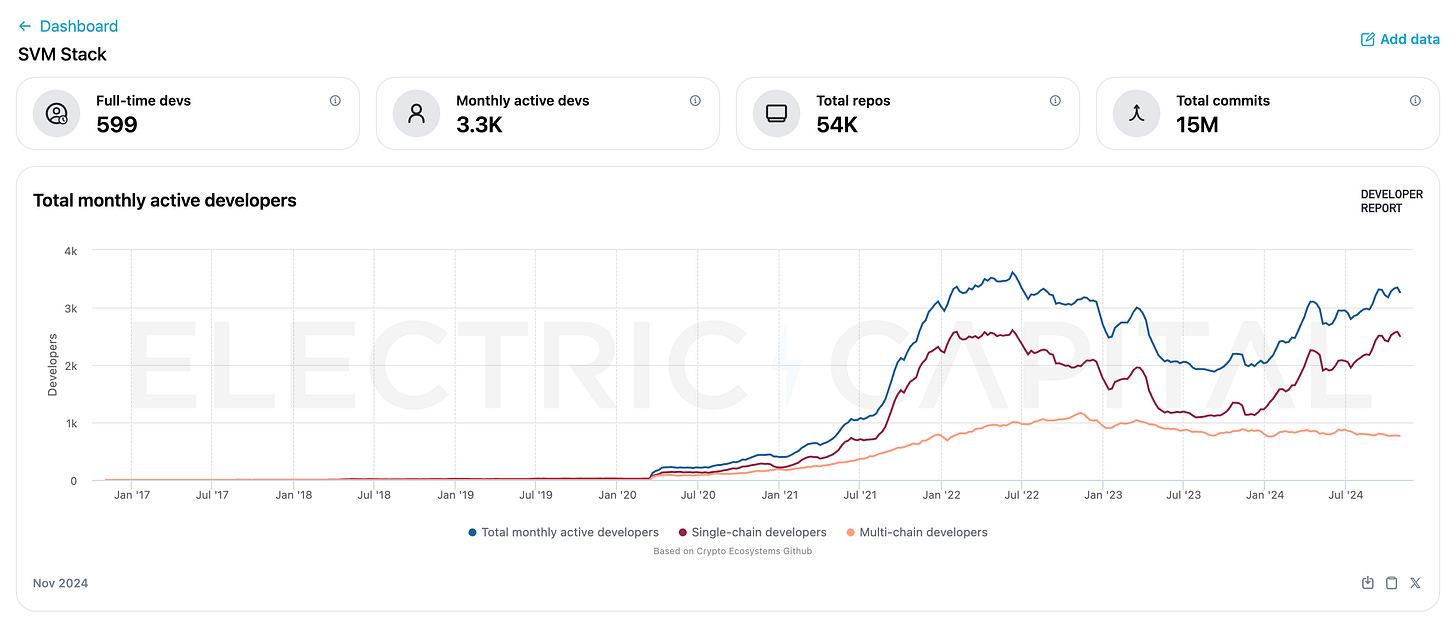【SOON】High-performance SVM rollup designed for Super Adoption Stack / L2 using SVM on Ethereum, SVM-based RaaS, and interoperability assurance / @soon_svm
Will it be a catalyst to expand SVM?
Good morning.
This is mitsui, a web3 researcher.
Today, I researched about "SOON".
🟩What is SOON?
⚙️Technical Features
🚩Transition and Prospects
💬Will SVM expand?
🧵TL;DR
SOON (Solana Optimistic Network) is an Optimistic Rollup infrastructure utilizing Solana VM (SVM).SOON Mainnet on Ethereum, SOON Stack that can be chained to any L1, and InterSOON for cross-chain communication to realize the "Super Adoption Stack.
SOON Mainnet achieves high-speed processing with the Ethereum settlement layer + SVM parallel processing engine, and combines reliability and scalability with Optimistic Rollup and EigenDA.
SOON Stack is an infrastructure group that enables one-click deployment of Solana-compatible L2 chains on any Layer 1, including Ethereum, BNB, and Base, as "Rollup as a Service".
InterSOON is a Hyperlane-based messaging protocol that provides wrap-free native interoperability, seamlessly linking assets and smart contract invocations across different chains.
🟩What is SOON?
SOON (Solana Optimistic Network) is a high-performance SVM rollup designed to enable the Super Adoption Stack.
With a vision of enabling mass adoption of blockchain, it consists of the following three main products
SOON Mainnet: a general-purpose Layer 2 network built on Ethereum
SOON Stack: Infrastructure that enables one-click deployment of unique SVM chains on any L1
InterSOON: Cross-chain communication protocol
By integrating these, we are trying to solve issues such as the fragmentation of liquidity and lack of interoperability between different chains, and to create a unified blockchain environment that connects all networks through a single interface.
We hope you have come across many proper nouns, so we will explain each one in turn.
◼️SOON Mainnet
This is a general-purpose Layer 2 chain that uses Ethereum as the settlement layer and employs Solana VM (SVM) as its execution environment, which is capable of high-speed parallel processing.It also uses OP Rollup as the L2 format and EigenDA as the DA layer.
As with regular rollups, the SOON SVM operates like a sequencer and rolls up to Ethereum for submission.The operating environment is SVM, which allows for parallel processing.
The technology stack includes "Decoupled SVM," "Merkleization," and "Horizontal Scaling," but these are all part of the technology core and will be explained later.
◼️SOON Stack
A "Rollup as a Service (RaaS)" infrastructure for developers and projects, enabling easy deployment of Solana-compatible high-speed L2 chains (SVM chains) on any Layer1.
It currently supports Ethereum as the payment layer and Avail as the DA layer, and also works with modular platforms such as Caldera and AltLayer.
We are also leveraging the SOON Stack to announce svmBNB with BNB as the payment layer and soonBase with Base as the payment layer.
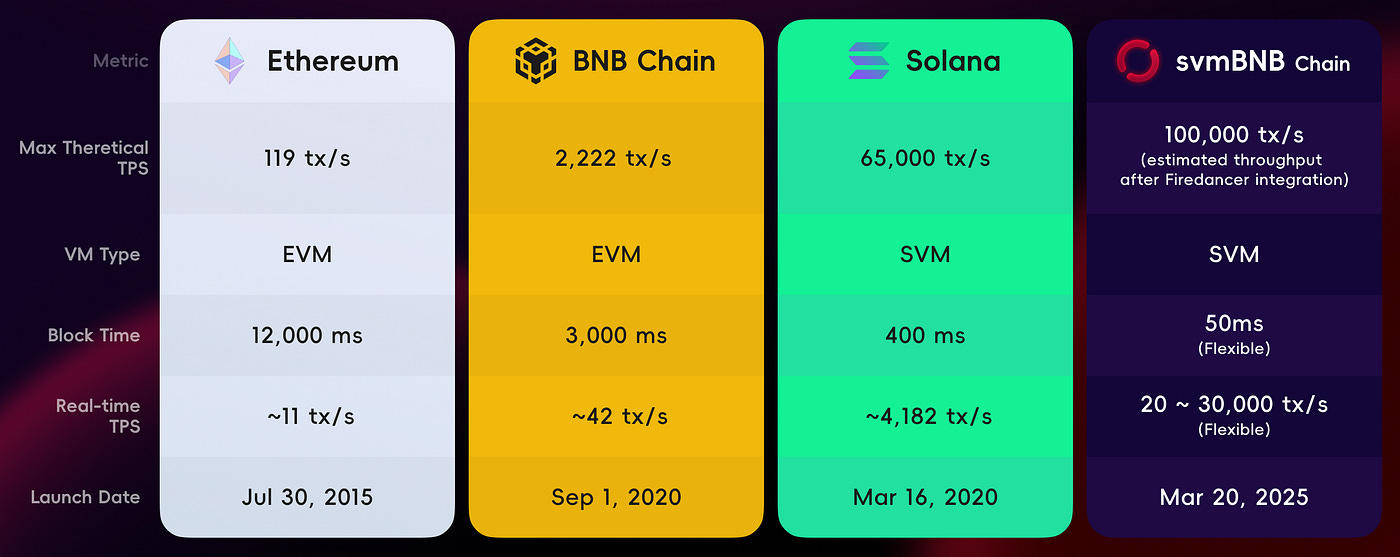
As you can see, we are building a series of chains that use the SVM execution environment for existing chains.We also make it easy to build up-chains utilizing SVM.
◼️InterSOON
This protocol is responsible for messaging between SOON Mainnet, multiple SOON chains, and other L1s, and provides native interoperability through cross-chain communication utilizing Hyperlane technology.
This mechanism allows smart contracts and assets on different chains to be exchanged directly without the need for bridge-wrapped assets, and has the advantage of not confining liquidity to each chain.
To illustrate, the image is as follows.
SOON Mainnet -> OP Mainnet
SOON Stack→OP Stack
InterSOON → Optimism Superchain
There is a flagship main chain, a development stack that can use that technology, and a cross-chain protocol that enables interoperability between all of them.
This vertical axis is the SVM, and the SVM is the chain building group that uses the SVM.
⚙️Technical Features
In the following section, more detailed technical features will be explained.
I will try to make the explanation as easy to understand as possible while also including prerequisite knowledge, but even so, there are still some difficult parts, so you may skip ahead.
SOON has three major technical features.
Decoupled SVM
Merklization
Horizontal Scaling
Explained one by one.
◼️Decoupled SVM
First, a bit of prerequisite knowledge about "VMs" is in order.
A virtual machine (VM) in blockchain is a software environment for executing smart contracts.
For example, Ethereum uses an EVM (Ethereum Virtual Machine), which executes contracts written in the Solidity language in sequence (single threaded).Solana, on the other hand, uses a Solana Virtual Machine (SVM), which has a mechanism to execute programs written in languages such as Rust in parallel.In other words, EVM can only process one transaction at a time, whereas SVM can process multiple transactions simultaneously to achieve higher throughput.
Now, let's get into the explanation of Decoupled SVM.
Decoupled SVM refers to an architecture in which the SVM (execution engine) is decoupled from the validator (consensus) layer of Solana, allowing the SVM to be used as a single execution layer.
Solana was originally designed as a monolithic consensus and execution environment, but this separation was made possible by a new SVM API (Agave) provided by Solana Labs in 2024.
SOON was the first project to take advantage of this technology, removing Solana's original consensus mechanism and extracting only the SVM to run on other L1s.
In the traditional Solana chain, the final consensus of the transaction was also done by Solana itself.In SOON, however, it is the other L1s that are responsible for consensus.
The key to the Decoupled SVM design is to decouple Solana's TPU (Transaction Processing Unit) from Solana's BFT consensus and instead have the roll-up sequencer control the TPU.
It does not use Solana's own block generation rules or voting protocols, but instead settles the transaction data and state root on the L1 (e.g. Ethereum) blockchain.Therefore, an SVM chain (SOON Chain) launched on the SOON Stack is compatible with existing chains, including components of Ethereum's OP Stack, while retaining Solana's fast execution capabilities.
There are three main advantages of Decoupled SVM.
The first is improved performance.Free from the heavy processing of consensus, the SVM can continuously generate blocks inside L2.In particular, Optimistic Rollup allows processing to proceed without waiting for successive responses from L1, thus maximizing the parallel processing capability of the SVM.
Second, security is enhanced.Separation of execution and agreement allows anyone to verify the results of SVM calculations.An independent verifier can recalculate the L2 state from the transaction information posted to L1 and fault-proof it in case of fraud, thus deterring malicious block generators.
Third, flexibility: since Decoupled SVM is now a neutral execution engine that can connect to non-Solana environments, it can be deployed on any data availability layer (such as Celestia) or L1 (such as Ethereum, Bitcoin, TON).
This modularization and abstraction of the SVM also makes it possible to launch "your own Solana chain" on the SOON Stack with a single click.
◼️Merklization
A concept that may not be familiar to you, but that you should understand with regard to blockchain state management, is the Merkle tree (this is a difficult one, so a quick read is OK).(This is another area that is difficult to understand, so a quick read is OK.)
In Ethereum, the overall state, including account balance and contract storage, is held in a tree structure called the Merkle Patricia Trie (MPT), and its root hash (state root) is recorded in each block.This allows any account state to be cryptographically provable by the tree route.
Solana, on the other hand, did not originally use such a Merkle tree for state management.However, in order to connect to other chains and to make the state verifiable, it is necessary to merkle the state (i.e., make the state into a merkle tree structure).
For this reason, SOON has introduced the Merkle Patricia Trie into the Solana account model, which periodically calculates and records a hash (snapshot) of the state.
Specifically, we have implemented a customized Merkle Patricia Trie for Solana's account model (a model where each account has data and is referenced by the program) to compute state routes at regular intervals.
This Merklization and state root verification is a key technology that acts like a snapshot on the blockchain and allows for trustless asset transfers between L2 and L1 (e.g., proof of asset withdrawal).
So it enables trustless asset bridging between chains.
In addition, SOON also ensures the persistence of historical data through Merkleization.While other SVM projects have limitations on how long state history can be kept (e.g., Solana itself keeps only the latest 150 slots, etc.), SOON keeps periodic snapshots on Ethereum for permanent history verification.
Such a design increases auditability and transparency and allows for advanced verification (e.g., retroactive matching) that is not possible with L2 alone.
◼️Horizontal Scaling
SOON embraces this horizontal scaling strategy, which is oriented toward designs that maintain performance under heavy loads.
Specifically, the SOON network allows multiple validator nodes (or sequencer nodes) to cooperate and share processing so that no one node is overloaded.The architecture can be expanded with virtually unlimited processing power by adding nodes, and can respond linearly to increases in the number of users and transaction volume.
◼️Future Outlook
These three technologies enable L2 with SVM as the execution engine (building a chain of SVM execution engines on top of other L1) and interoperability between SVM chains.
SOON itself is scheduled to be fully deployed in the future, but I would like to mention some of the planned technical enhancements from a technological perspective.The main pillars are the introduction of ZK rollup technology and the integration of the new "Firedancer" client for Solana.
The SOON team has announced plans to incorporate Zero Knowledge Proof (ZK Proof) in the future.Specifically, SOON intends to adopt instant verification with cryptographic proofs to shorten the one-week challenge period required for the Optimistic Rollup.According to public information, SOON is considering adopting ZK technologies such as RISC Zero and SP1, which will be incorporated after mainnet launch to significantly reduce withdrawal latency.
Another hot topic is the use of Solana's new client, Firedancer, a validator client for Solana being developed by Jump Crypto, which has made headlines for its theoretical performance of 1 million TPS, thanks to its highly efficient concurrency processing written in C++.It has become a topic of conversation.
SOON plans to integrate Firedancer into the SOON Stack once it is stable.
Specifically, SOON aims to improve the throughput of the entire SOON chain by replacing or optimizing the SVM execution engine used by SOON with technology derived from Firedancer.In fact, SOON's development network has already reported achieving 80,000 TPS per second through Firedancer integration, and in the future, Firedancer + SVM may be able to achieve processing speeds several hundred times faster than the current EVM rollup.
🚩Transition and Outlook
SOON was founded in 2024 by Joanna Zeng, who has a proven track record of leading business development and partnership strategies for prominent projects such as Coinbase, Optimism, and Aleo.
Andrew Zhou, the other co-founder and CTO, is an engineer with 5 years of development experience at Rust and 6 years at Golang, known for his expertise in smart contract development and building Layer 1 solutions.
SOON has garnered industry attention prior to its release and has received funding and support from a number of prominent angel investors.
The completion of the first funding round was announced in August 2024, and investors include Solana Labs co-founder Anatoly Yakovenko (Toly), Solana Foundation President Lily Liu, Coinbase Ventures Head Jonathan King,Celestia Labs co-founder Mustafa Al-Bassam, AltLayer co-founder Amrit Kumar, and Avail co-founder Prabal Banerjee.Since then, the company has raised multiple rounds of funding.
The transition to date includes the launch of the Alpha version of the "Decoupled SVM" implementation of the mainnet on Ethereum in late 2024 and early 2025, the official launch of the SOON Alpha Mainnet and the release of the token economics overview on January 3, 2025, and theThe company has also
At this point, policies such as "51% allocation to the community" and "no VC privileges" were announced, clearly indicating the community focus.
In the spring of 2025, multi-chain deployment using the SOON Stack was in full swing.
In April, the "soonBase" testnet began operating on Coinbase's Base chain in addition to Ethereum, and at the end of the same month, the SOONBase mainnet operation was announced.SVM Rollup (svmBNB) is also deployed on the BNB chain, and these multiple L2 chains are connected by SOON's cross-chain functionality.
In May 2025, Simpfor.fun V2, a product for general users, was released to begin proof of concept and community expansion of LiveTrade.
Simpfor.fun V2 is a major update version of the on-chain copy trading platform offered on the SOON network and was officially released on May 23, 2025.
Users can copy the trading strategies of large addresses, called "smart money," with a single click, designed to handle not only BTC and major stable coins, but in the future, gold and other RWA tokens as well.
A data analysis dashboard is built into the platform that allows you to see profit/loss (PNL), ROI, and position valuations in real time, giving you an intuitive view of your assets and the performance of the trader you are copying from.
Another key feature is the "LiveTrade" live streaming integration function, which allows users to induce copy trades with a single click from distribution plug-ins such as Twitch and SOOP.
Distributors can earn up to 80% referral commissions each time a viewer copies their strategy, providing a natural on-chain trading experience for Web2 users who previously lacked trading knowledge.
In addition, the token economics have been modernized to coincide with the release of V2, officially supporting multi-chain support for Ethereum, Binance, and Base, making Simpfor.fun a key driver in the revitalization of the entire SOON ecosystem.
Also announced at this time is the upcoming TGE of $SOON tokens, with initial distribution and listing expected in June 2025.
◼️ token-economics
The $SOON will have an initial total issuance of 1 billion, increasing at an inflation rate of 3% annually thereafter.Allocations are as followsIn addition, $SOON tokens will be deployed simultaneously on several blockchains such as Solana, BNB chain, and Base chain.
The following utilities are envisioned
Governance
Gas Fees
Staking and Validator Rewards
Ecosystem Rewards
Access to new SOON ecosystem products and preferential treatment
As mentioned above, a majority of the initial issuance, 51%, is allocated for the community, and there is a stated policy of no pre-mining or privileged distribution to early VCs.
💬Will SVM spread
The last section is a summary and discussion.
There are a few technical explanations, but the bottom line is that this is a project to expand SVM.
SVM has seen a tremendous increase in developers, driven in part by the growth of Solana.
Over the past year, the number of full-stack engineers is the only one that has grown in the top ranks.
If you look at the SVM Stack, that number is on the rise.However, the number of full time developers is still small.
The Solana consensus and SVM were separated last year, and SOON became a product of the Solana consensus and SVM, which became fully operational this year, so it is possible that new chains will become SVM one after another in the future.
What I found interesting is that Solana is cooperating with SOON to a great extent.
As mentioned in the article on whether Solana needs L2, Solana itself does not need L2 and aims to make L1 monosyllabic and best scalable.
Solana is aggressive about expanding SVM itself.I think this is aimed at creating a world where assets are bridged from existing EVMs and other L1s to Solana, thus building Solana's advantage.
In fact, it cannot be dismissed that Ethereum is strong because it is a language in which EVM is used a lot.When it comes to SVM, Solana's advantage will definitely increase.
The battle for market share in this area will be interesting to watch in the future.Also, SOON itself seems to be going into full-scale operation, and may become one of the projects to watch in the future.
The above is a description of SOON!
🔗Reference Link:HP / DOC / X
Disclaimer:I carefully examine and write the information that I research, but since it is personally operated and there are many parts with English sources, there may be some paraphrasing or incorrect information. Please understand. Also, there may be introductions of Dapps, NFTs, and tokens in the articles, but there is absolutely no solicitation purpose. Please purchase and use them at your own risk.
About us
🇯🇵🇺🇸🇰🇷🇨🇳🇪🇸 The English version of the web3 newsletter, which is available in 5 languages. Based on the concept of ``Learn more about web3 in 5 minutes a day,'' we deliver research articles five times a week, including explanations of popular web3 trends, project explanations, and introductions to the latest news.
Author
mitsui
A web3 researcher. Operating the newsletter "web3 Research" delivered in five languages around the world.
Contact
The author is a web3 researcher based in Japan. If you have a project that is interested in expanding to Japan, please contact the following:
Telegram:@mitsui0x
*Please note that this newsletter translates articles that are originally in Japanese. There may be translation mistakes such as mistranslations or paraphrasing, so please understand in advance.



